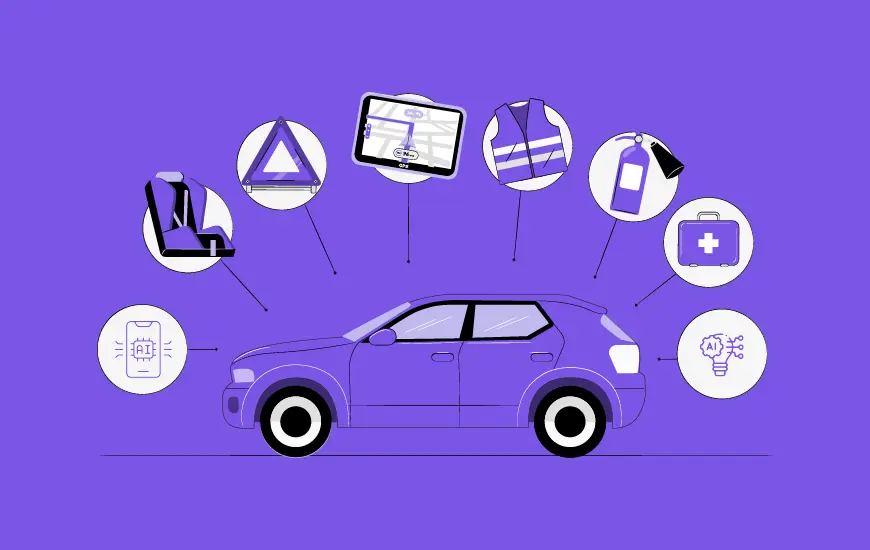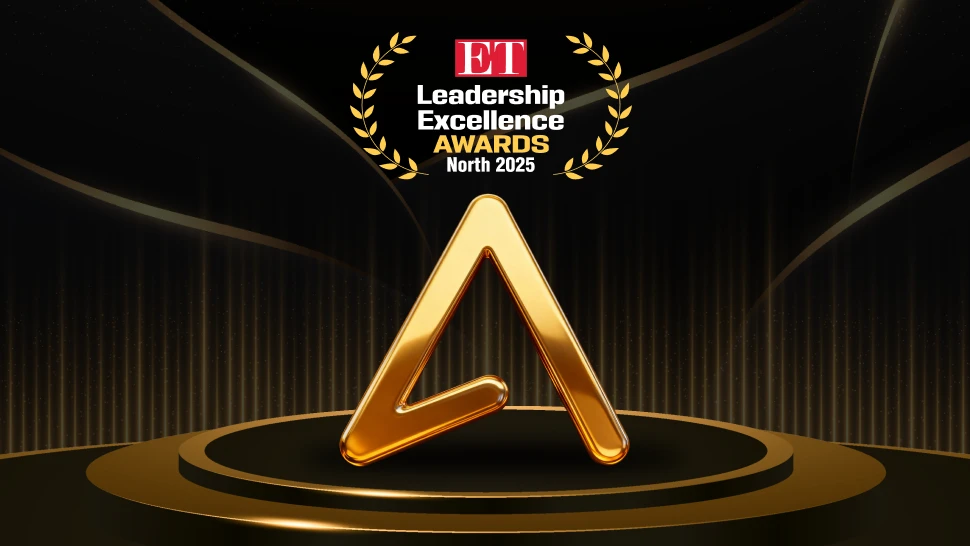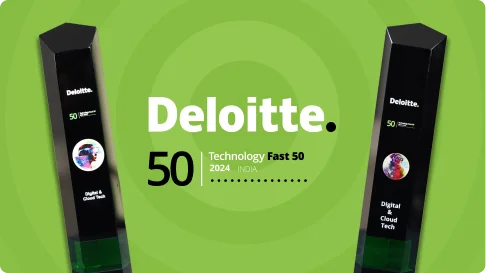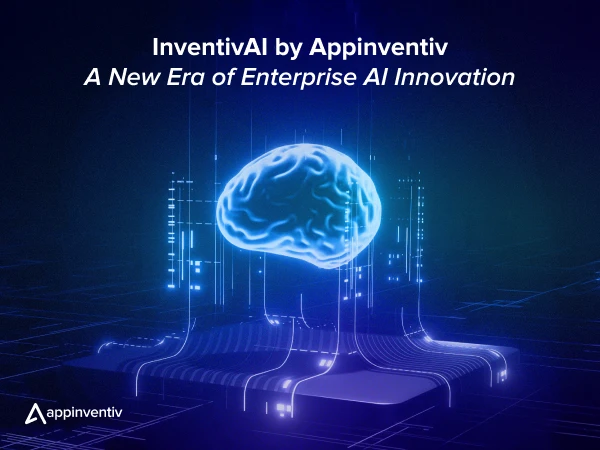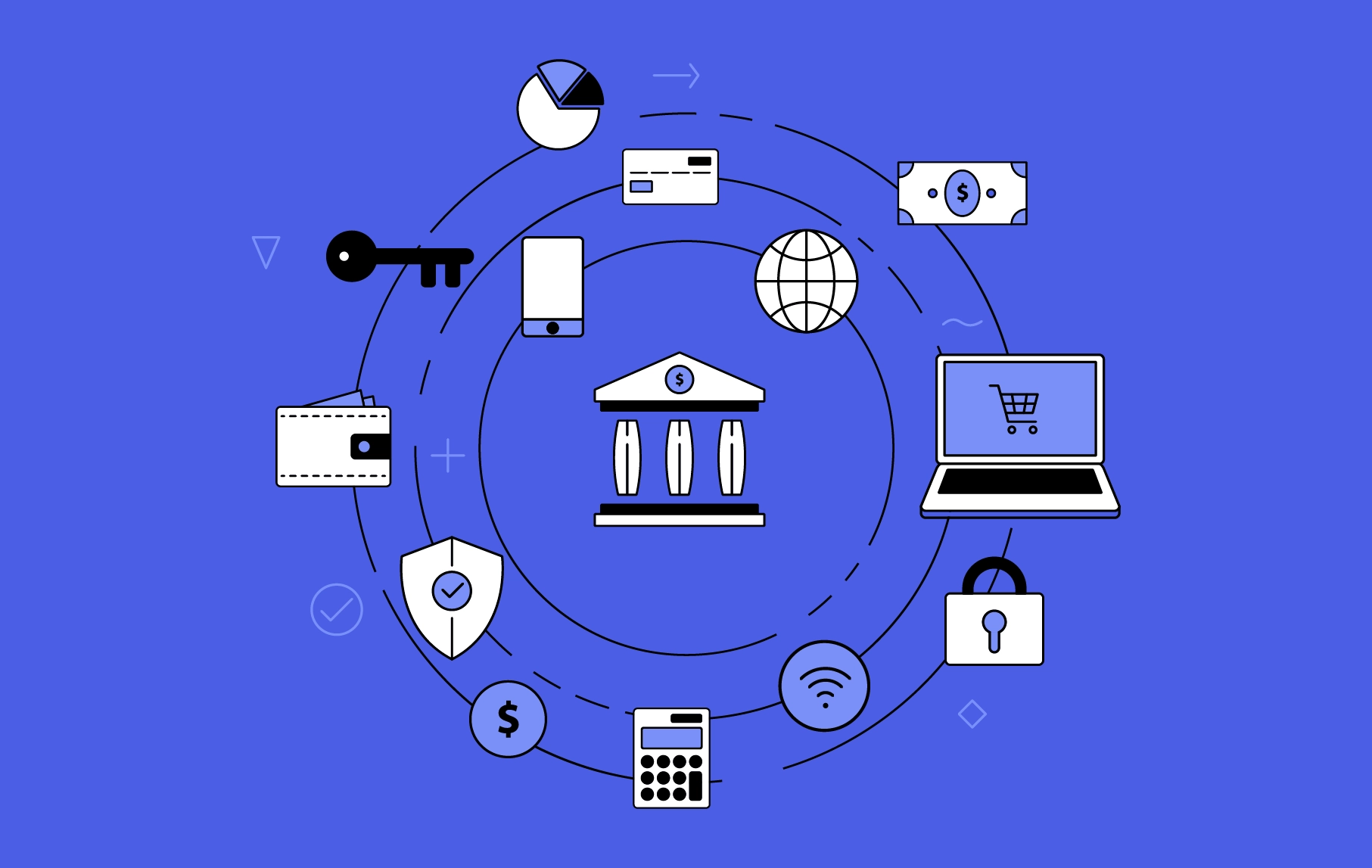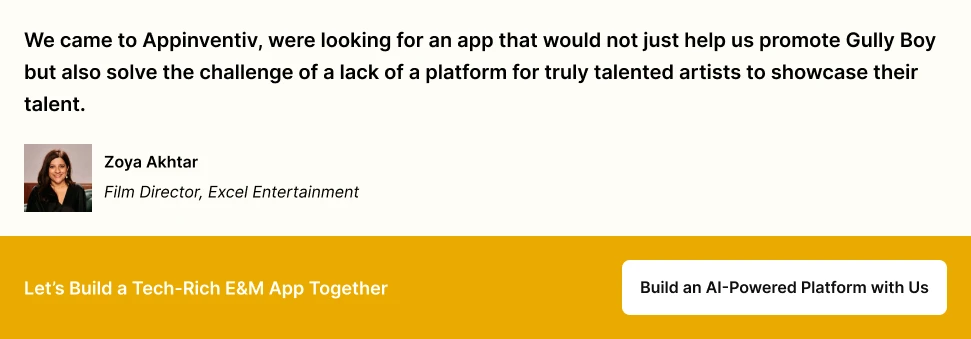- Current Challenges Reshaping the Media and Entertainment Industry
- Content Saturation and Discovery Problems
- Revenue Distribution Complexities
- Technological Infrastructure Demands
- Consumer Fatigue and Subscription Overload
- Unveiling the Existing & Emerging Media and Entertainment Industry Trends
- Trends on the Demand Side of the Media & Entertainment
- Tech Trends on the Supply-Side of the Media & Entertainment Industry
- What's Hot Right Now: Latest Trends in the Media and Entertainment Industry in 2025
- Social Media is Eating Traditional TV's Lunch
- Gaming Isn't Just Gaming Anymore
- Real-World Experiences Are Making a Comeback
- Green Production is Getting Serious
- Where We Are Headed: Future of the Media and Entertainment Industry
- Entertainment That Lives Everywhere
- Anyone Can Be a Creator Now
- Predicting What You'll Want Before You Know You Want It
- Industry Consolidation and Strategic Alliances
- How Can Appinventiv Help You Keep Pace with the Media and Entertainment Industry Trends
- FAQs
- The media and entertainment industry is undergoing a digital transformation, driven by a blend of consumer behavior and tech trends.
- Consumer preferences for D2C streaming, hyper-personalization, and omnichannel experiences are forcing platforms to adapt with smarter content delivery.
- Technologies like AI and AR/VR are deeply impacting content creation, optimization, and audience engagement.
- Gaming is a significant and growing segment of the entertainment sector, influencing broader entertainment trends.
Imagine a world where stories unfold not just on screens but in the air around you, where music hums in sync with your heartbeat, and where every viewer feels like the hero of their own tale. That’s the future of the media and entertainment industry, and it’s not a distant dream—it’s 2025, and it’s happening now. The media and entertainment industry trends in 2025 are reshaping how we create, consume, and connect with content.
This transformation is driven by a symphony of technologies that turns a simple storytelling medium into a digital ecosystem that adapts, learns, and personalizes every interaction. Think about Netflix, how this streaming giant somehow knows exactly what you want to watch after a long day. That’s not magic—that’s the new reality of entertainment technology working behind the scenes.
The current numbers tell the untold story. The global media and entertainment market reached an impressive $2.9 trillion in 2024, with projections pointing to $3.5 trillion by 2029 (Source: PwC’s Global E&Media Outlook 2025-2029). This represents a compound annual growth rate (CAGR) of 3.7%, and an expected $577 billion in incremental new revenues by 2029.
What’s particularly fascinating about these numbers is how digital formats now dominate a massive chunk of the entertainment market. However, this shift isn’t just about numbers; it is also about how stories reach audiences.
Let’s dive into the technology trends in the media and entertainment industry that are scripting this transformation, with a nod to what’s new and what’s next.
Transform your entertainment ideas into a market-winning product now.
Current Challenges Reshaping the Media and Entertainment Industry
The media and entertainment industry is tasked with providing access to important information and top content quickly and effortlessly to viewers, presenting industry professionals with multiple challenges. Therefore, before we jump into the exciting trends, let’s talk about a few current challenges that are faced by the media and entertainment industry:
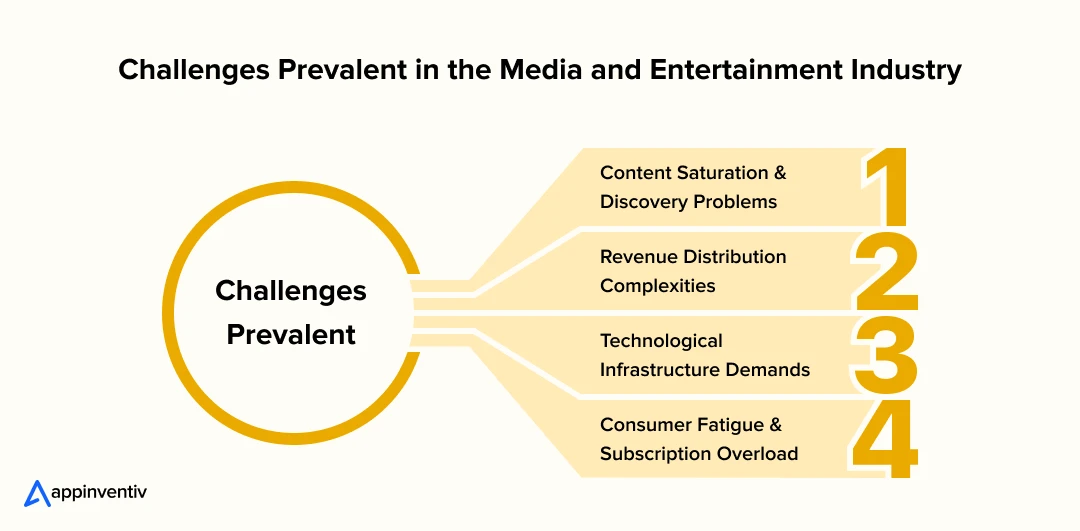
Content Saturation and Discovery Problems
The modern viewer faces an overwhelming paradox: infinite content choices but increasing difficulty finding what they actually want to watch. Platforms now host millions of hours of content, creating what industry experts call “the discovery crisis.”
Revenue Distribution Complexities
The traditional revenue-sharing model faces disruption as content creators seek more direct relationships with audiences. This is why we are seeing creator economy platforms and direct-to-consumer models popping up everywhere. Companies and creators ask, “Why should middlemen take such a big cut?”
Technological Infrastructure Demands
As content quality improves—with 4K becoming standard and 8K emerging—the infrastructure costs for storage, processing, and delivery are skyrocketing. Companies are walking a tightrope between meeting viewer expectations and keeping their operations profitable.
Consumer Fatigue and Subscription Overload
People are getting overwhelmed by their monthly entertainment bills. Between Netflix, Spotify, HBO Max, and who knows what else, content consumers are starting to think, “Do I really need all these subscriptions?” This fatigue is making companies nervous about how sustainable their growth really is.
Unveiling the Existing & Emerging Media and Entertainment Industry Trends
To truly grasp the ongoing transformation within the media and entertainment industry, we must look at it from two distinct yet interconnected vantage points. On one side, we have the evolving desires and habits of the audience – the demand side. On the other hand, we observe the innovations and capabilities of the industry itself – the supply side. Together, these two currents shape how stories are told and consumed in our modern age. Let’s take a deep dive into both these trends:
Trends on the Demand Side of the Media & Entertainment
The demand side represents the audience – you, me, and everyone else who consumes media and entertainment. These trends are directly or indirectly influenced by audience preferences, behaviors, habits, and expectations. In this section, we’ll mention the most palpable demand-side (consumer-end) media and entertainment industry trends.
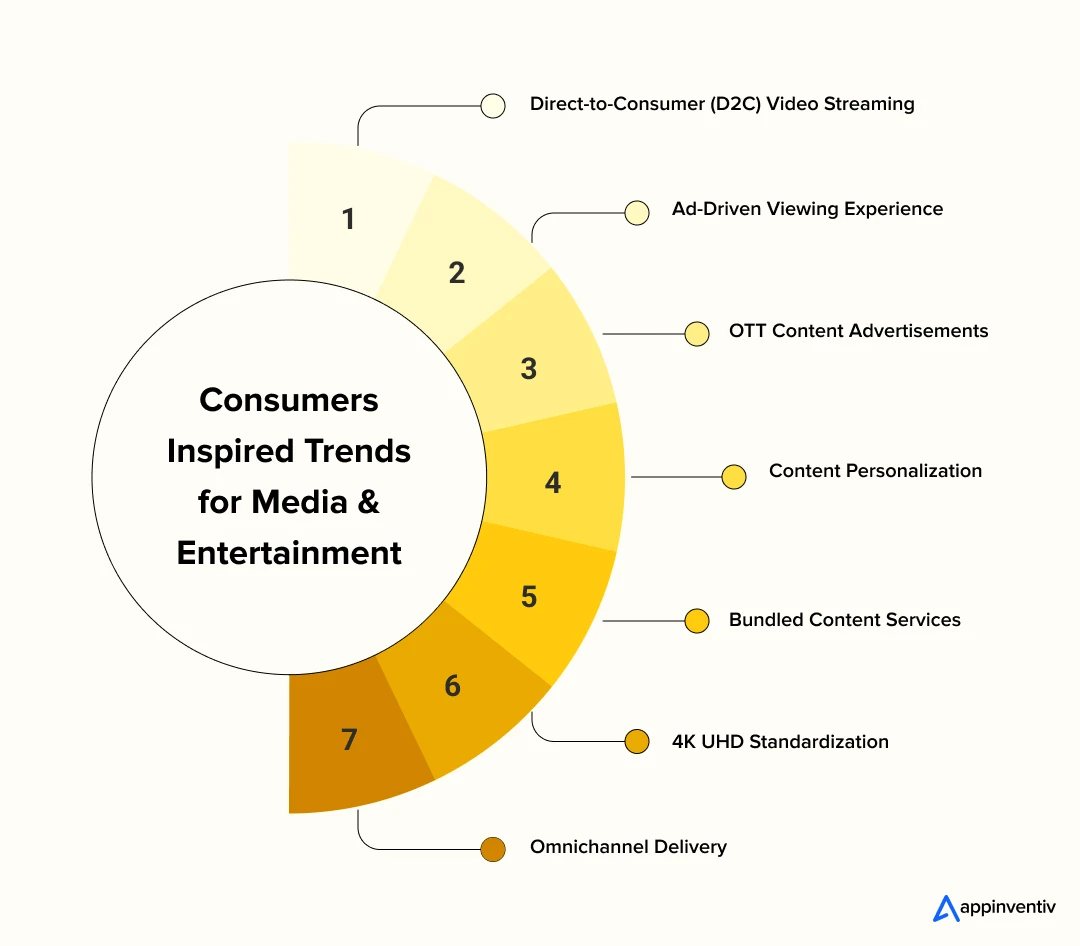
Direct-to-Consumer (D2C) Video Streaming
The explosion of D2C video streaming platforms, such as Netflix, Disney+, and Amazon Prime, has fundamentally changed how we consume entertainment. The COVID-19 pandemic accelerated this shift, pushing consumers to embrace on-demand content like never before.
But the real game-changer? Disney’s strategic move to pull content from Netflix and launch Disney+ marked the start of an industry-wide trend toward in-house streaming services. Now, major media players like NBCUniversal with Peacock and WarnerMedia with HBO Max are following suit, offering exclusive content directly to consumers.
The downside? Subscription fatigue. A recent survey reveals that the average consumer subscribes to just three video streaming services, and this number has remained steady over the past two years. (Source: Statista)
To tackle this, companies are offering bundled services. The prime example (pun intended) of this trajectory is none other than Amazon Prime and Roku. In addition to video, these vendors create customized, pay-as-you-go packages for accessing the music and game libraries.
Ad-Driven Viewing Experience
One of the reasons mobile streaming catches users’ attention and hooks them to the platform is that it cuts down on ads. But ads are back, and ad-supported video on demand (AVOD) is smarter than ever. Major platforms like Netflix and Disney+ have introduced lower-cost, ad-supported tiers, and digital advertising is now the dominant revenue stream for many entertainment companies. Advanced AI-driven ad tech allows platforms to offer highly targeted, relevant ads, increasing effectiveness for advertisers and minimizing disruption for viewers.
The gaming world led this charge. Video game advertising revenue has exploded because gamers don’t mind ads when they win some existing rewards after watching the ads. In fact, they are willing to watch ads to improve their gaming experiences. This represents one of the most significant current trends in the media and entertainment industry, where the lines between content and advertising are getting beautifully blurred.
OTT Content Advertisements
Short breaks or ads have always been the buzzkill of our entertainment. One of the fundamental reasons behind customers shifting towards streaming on digital platforms like Netflix and Amazon Prime is that they can watch their preferred shows without being hindered by advertisement breaks at regular intervals.
Digital platforms have become a premium experience for crowds, and the ad-free experience is viewed as the best feature of these platforms.
Earlier viewers used to sit patiently and wait for YouTube adverts to complete, while TV watchers are bound to leave the room or change the channel to try to avoid watching them. But this scenario has totally changed now. Even on YouTube, now viewers don’t prefer ads and wait for the ‘skip ads’ button towards the bottom right of videos.
With so many YouTube ads hindering the viewing experience, it has introduced its ad-free version, ‘YouTube Premium’. This is a digital streaming trend in 2025, and we can hope that as time passes, this too will advance in its own way.
Content Personalization
Ever notice how Netflix seems to read your mind? That’s not luck—that’s sophisticated AI working overtime to understand your viewing patterns. These recommendation engines have become so good that they’re driving most of what people watch.
This level of personalization has become the baseline expectation. Platforms are investing massive amounts in media and entertainment technology to understand not just what you watch, but when you watch it, how you watch it, and what mood you’re in when you do.
Bundled Content Services
Remember cable bundles? Well, they’re back, but smarter. Instead of forcing you to pay for channels you’ll never watch, platforms are creating themed packages that actually make sense. Want horror movies, true crime podcasts, and thriller games all in one package? Done. This strategic bundling represents the latest technology trends in the media and entertainment industry, as companies strive to maximize the value each user receives while paying a fair price.
4K UHD Standardization
This may be of utmost importance, especially to traditionally broadcast TV station businesses. The uptake of 4K ultra-HD TV units has surprisingly increased, and advanced viewing devices are becoming increasingly common in homes globally.
Major streaming services like Netflix, Amazon Prime, Hulu, HBO, and others offer content in 4K. Primary game console producers Sony and Microsoft have also immersed themselves in delivering high-definition content. This has created a 4K UHD standardization in the media and entertainment industry, and businesses are looking forward to creating content that aligns with users’ demands.
Omnichannel Delivery
The fast download speed on various devices has raised the bar, where users want it all instantly. This shows the user’s interest in accessing varied content on their mobile devices.
Along with that, users want the content to be interconnected, so that they can watch their favorite series or shows anywhere, at any time, from any device.
So, if you have a live streaming website, you must not delay in getting your business app developed by the top entertainment software development company.
Related Article: How Are Mobile Apps Revolutionizing the Entertainment Industry
Tech Trends on the Supply-Side of the Media & Entertainment Industry
The emerging trends in the entertainment and media industry mentioned above have been directly derived from user behavior, i.e., if the users hadn’t reacted to digital media apps the way they did, we probably wouldn’t be seeing much commotion in that zone.
But on the supply side, trends are driven by technological advancements. Thus, in this section, we’ll look at the emerging technologies that are affecting the way in which media enterprises go about their business.
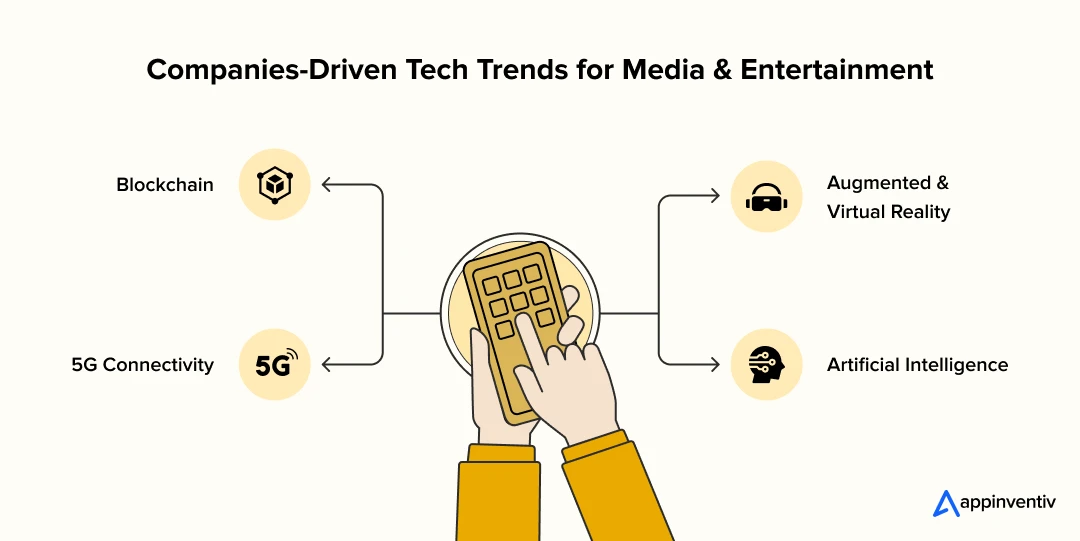
Blockchain
Here’s something most people don’t think about: how do you fairly split revenue when a song gets streamed millions of times across dozens of platforms? Blockchain technology is solving this headache by automating payments through smart contracts.
Plus, NFTs are creating brand new ways for creators to monetize their work directly with fans. This tech addresses real problems in media and entertainment technology around transparent payments and proving who owns what.
5G Connectivity
Fifth-generation wireless networks are eliminating those annoying buffering moments and making cloud gaming actually playable. Most importantly, they’re enabling real-time, interactive experiences that were previously impossible.
This infrastructure upgrade supports digital transformation in media and entertainment by removing the technical barriers that used to limit what content creators could achieve.
Augmented & Virtual Reality
The past few years have seen much hype but less adoption of AR/VR. But now the time has changed. VR and AR are no longer just gaming gimmicks. They are fast becoming legitimate entertainment platforms. Musicians are hosting virtual concerts that feel almost as real as being there in person. Movie theaters are experimenting with 360-degree experiences where you’re literally inside the story.
Gaming still dominates this space, but that’s changing fast. These immersive technologies represent emerging trends in the media industry where the line between watching and participating completely disappears.
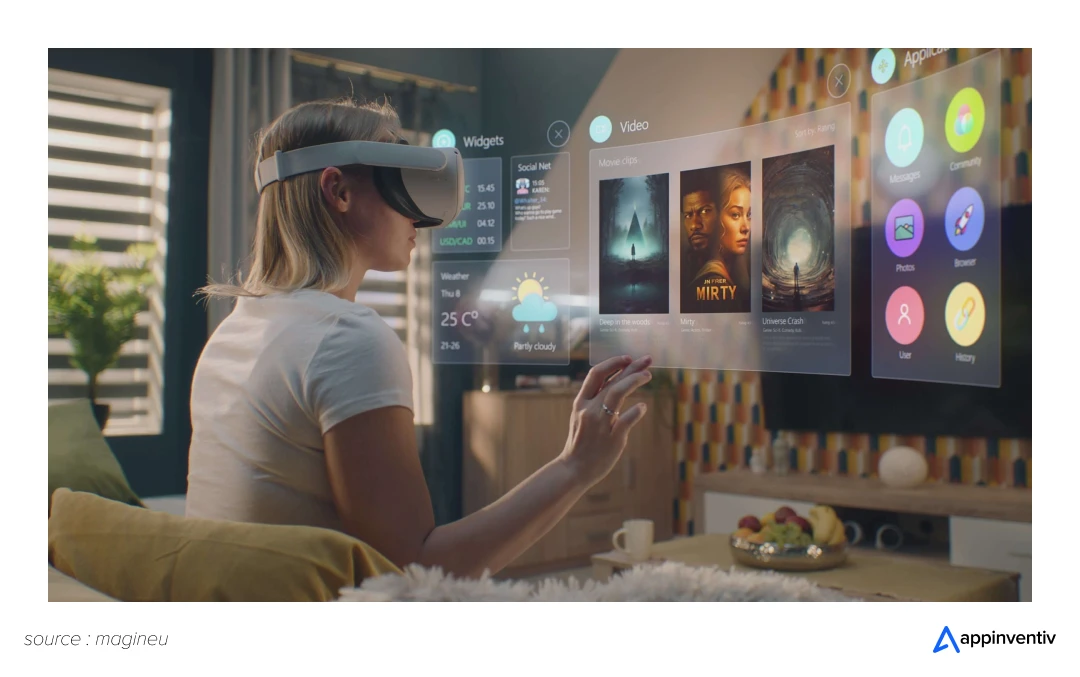
The media entertainment industry will make use of the AR/VR technological trends in the following ways:
- Act as a substitute for high-priced joysticks and keyboards, at the same time delivering a quality experience to gamers.
- Be the de facto technological genre for media app development companies, especially in the field of digital education.
- Help in enterprise-level media software development for learning management solutions.
- Possibly make way into theatres and cinemas to reinforce the power of digital effects through immersion.
- Create wearables for visitors headed to museums, art galleries, etc., and represent artifacts with added features/info.
Artificial Intelligence
There is not a single subset of M&E that has not been impacted by AI. Its predictive powers are influencing television, animation, VFX, Out-of-Home advertising (OOH), radio, and much more. The global AI in media & entertainment market jumped from $25.98 billion in 2024 and is expected to hit $99.48 billion by 2030 (Source: Grand View Research).
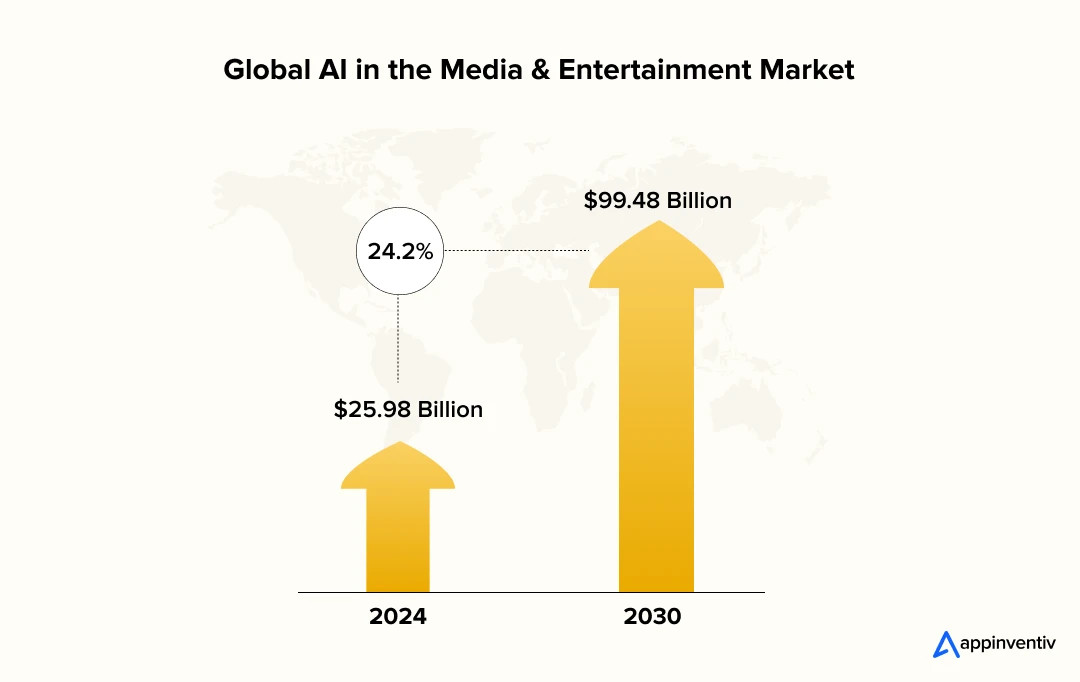
But what does this actually mean for you as a viewer? A case in point is the following applications of AI in the media and entertainment industry.
- M&E companies hold a huge repository of user data at their data centers. In many cases, the data is largely unstructured, i.e., like a mound of hay waiting to be made sense out of. AI has added a cognitive, human-like dimension to mining and saturating this unstructured data.
- Engineers are using and integrating AI, ML, and Natural Language Processing to apply relational parameters to big data. The technology helps categorize the data as on mutual characteristics and further consolidates a company’s predictive capacity to forecast user engagement with the content. This targeted efficiency leads to better monetization opportunities.
- AI is being applied readily to video content to speedily calculate and absorb emotional changes on the user side. The summary of such studies is then used for highly customized content recommendations. The same principle is at play in music streaming apps that know precisely which songs to pitch to you, which eventually make it to your favorite list.
- AI helps writers brainstorm ideas and polish dialogue, but humans still drive the creative vision.
- The cost of content creation will be vastly reduced following the advent of AI that can write and automate editorials, consequently mitigating human intervention.
What’s Hot Right Now: Latest Trends in the Media and Entertainment Industry in 2025
The entertainment landscape is shifting faster than a viral TikTok trend, and what’s hot today might be old news tomorrow. But some patterns are emerging that seem to have real staying power for decades. These aren’t just fleeting fads—they’re reshaping how we think about entertainment itself. Let’s explore what’s actually driving the current technology trends in the media and entertainment industry and why they matter for both creators and consumers.
Social Media is Eating Traditional TV’s Lunch
Typically, 56% of Gen Z and 43% of millennials say social media content matters more to them than traditional TV shows and movies (source: Deloitte’s 2025 Digital Media Trends). This isn’t just a preference shift—it’s a fundamental change in how entire generations consume entertainment.
TikTok videos and Instagram Reels aren’t just competing with TV shows anymore; they’re often more engaging and relevant to younger viewers. Traditional media companies are scrambling to figure out how to adapt their decades-old distribution strategies to this new reality.
Gaming Isn’t Just Gaming Anymore
Gaming has broken out of its entertainment box and become a social platform, a cultural influencer, and an economic powerhouse all rolled into one. Esports events now draw bigger crowds than many traditional sports, and gaming livestreams are creating entirely new categories of celebrities.
But here’s what’s really interesting: games are becoming the testing ground for new technologies that eventually make their way into other forms of entertainment. The innovations happening in gaming today often become the trends in the entertainment industry tomorrow.
Real-World Experiences Are Making a Comeback
While everything was going digital, something unexpected happened—people started craving physical experiences tied to their favorite content. Theme parks based on popular shows and movies are booming. Branded entertainment districts are popping up in major cities. Interactive museum exhibits let you step into your favorite fictional worlds.
These location-based experiences represent Media & Entertainment Industry predictions coming true: the most successful entertainment brands don’t just live on screens—they create entire worlds you can actually visit and experience.
Green Production is Getting Serious
Environmental consciousness isn’t just a nice-to-have anymore—it’s becoming a business necessity. AI-powered tools are helping production companies cut energy use during editing and rendering. Cloud-based workflows mean less travel for remote collaboration without sacrificing creative quality.
This shift toward sustainable production practices represents practical applications of digital media and entertainment trends that benefit both the bottom line and the planet.
Partner with an experienced entertainment app development company that turns raw concepts into a groundbreaking reality.
Where We Are Headed: Future of the Media and Entertainment Industry
If you think entertainment has changed a lot in recent years, buckle up; we are just getting started. The future of the media and entertainment industry is not about bigger screens or louder speakers; it’s about entertainment that thinks, adapts, and becomes part of your life in ways we are only beginning to imagine. We are moving toward a world where the line between consuming entertainment and living it completely disappears. Here’s what that actually looks like in practice.
Entertainment That Lives Everywhere
The future is not about sitting down to watch something—it’s about entertainment that weaves into your daily life. Smart home systems that adapt to your routines, augmented reality overlays that add digital stories to your real-world environment, and voice-first experiences designed for people who are always multitasking.
Entertainment will become less about dedicated viewing sessions and more about continuous, contextual engagement that fits naturally into how you actually live.
Anyone Can Be a Creator Now
AI tools are democratizing content creation in ways we’ve never seen before. Individual creators can now produce professional-quality content without needing a full production team or massive budget. Generative AI platforms like Midjourney, DALL·E, and Runway are enabling creators to generate high-quality visuals and videos with minimal effort.
This integration of AI will expand creative possibilities and completely shake up the traditional studio system by lowering the barriers to entry for content production. Indeed, we are moving toward a world where the next big entertainment hit might come from someone working out of their bedroom, not a Hollywood studio.
Predicting What You’ll Want Before You Know You Want It
Advanced AI analytics are getting so sophisticated that platforms will soon commission content based on predicted audience demand before scripts are even written. Instead of gambling on what might work, content investment will become more data-driven and user-centric.
Industry Consolidation and Strategic Alliances
As competition intensifies and costs rise, the industry is seeing a wave of mergers, acquisitions, and strategic partnerships. Media giants are joining forces to achieve greater scale, share technology investments, and expand their content libraries. This consolidation is reshaping the competitive landscape and determining which players thrive in the next era of entertainment.
How Can Appinventiv Help You Keep Pace with the Media and Entertainment Industry Trends
The media and entertainment world moves at lightning speed, and staying alive in this fast-changing space is not just about knowing what’s coming. It is much more about partnering with an experienced entertainment app development company that can bring your vision to life.
At Appinventiv, we have been helping media and entertainment companies elevate their digital transformations for 10+ years. Our skilled team of 1600+ tech experts specializes in turning complex industry trends into practical, profitable solutions.
Whether you’re looking to build a streaming platform that rivals Netflix, create an AI-powered content recommendation system, or develop immersive AR experiences that captivate audiences, we understand the unique challenges of the entertainment industry. Our team has worked with everyone from indie content creators to major entertainment brands, and we know what it takes to build technology that actually engages users and drives results.
We help you identify which trends are worth investing in and which ones are just hype, ensuring your technology investments actually move your business forward.
For instance, we developed Gully Beat, an entertainment app that gave voice to the streets, nationwide. The app allows aspiring rappers to create and share their tracks in minutes, perfectly capturing the DIY rap culture.
The entertainment industry waits for no one, and neither should you. Transform your entertainment business with technology that keeps pace with tomorrow’s trends now. Take a minute and connect with us, and we’ll showcase how you can slingshot your idea to glory.
FAQs
Q. What is the cost of entertainment app development?
A. The cost of entertainment app development ranges between $40,000 and $400,000 or more, depending on your unique project requirements. For instance.
- Simple apps with basic features – $40,000 to $100,000
- Medium complex apps with additional features – $100,000 to $200,000
- Highly complex app with advanced features – $200,000 to $400,000
- Enterprise-level app with complete feature set – $400,000 to $600,000+
Q: What are some great features you can use in your music/entertainment app to help expand your brand?
A. A few of the great features you can implement in your music/entertainment app are:
- Social wall feature
- Push notifications
- GeoFence feature
- Social media integration
- Image gallery and Info slider feature, etc
Q. How much does a video streaming app development like Netflix cost?
A. The Netflix-like app development cost depends on the three factors:
- The complexity of the app and the number of features
- The number of platforms you want the application to work on
- The geographical location of your partnered development company
To give you more insights, we have created a detailed article on the same.
Q. What is the tech stack needed to develop a social media app?
A. An effective technology stack can assist you in developing a successful social media app. It can be divided into two segments: the front end and the back end.
For front-end development, you will need:
- Javascript
- Angular 2
- Jasmine framework
- CSS
- HTML
For back-end development, you will require:
- Ruby
- Ruby on Rails as a Framework
- Puma for the application server
- Database
- Storage
Q. What technologies are driving innovation in the media and entertainment sector?
A. The core technologies driving innovation in the media and entertainment sector are Artificial Intelligence (AI), Augmented Reality (AR), Virtual Reality (VR), Internet of Things (IoT), cloud, and Blockchain.
These tech trends in the media and entertainment industry are significantly reshaping content creation, delivery, and consumption.
Q. What role does AI play in media and entertainment?
A. AI in the media and entertainment sector acts like a creative assistant that never gets tired. It powers the recommendation engines that help you discover new content, automates the tedious parts of video editing, and enables real-time content adaptation based on how engaged you are. The technology also facilitates multilingual dubbing and subtitling, making global content accessible. Basically, AI handles the technical heavy lifting so creators can focus on storytelling.
Q. What is the future of the media and entertainment industry?
A. The future of media and entertainment is characterized by highly personalized, interactive, and immersive experiences. It will see further convergence of technology and content, with AI and AR/VR leading the charge. These tech trends will create new forms of storytelling and engagement, alongside evolving business models.


- In just 2 mins you will get a response
- Your idea is 100% protected by our Non Disclosure Agreement.

How Much Does It Cost to Build a Live Streaming App Like Kick and Rumble?
Have you ever wondered why there's a global surge in the demand for live streaming apps and why businesses are increasingly turning towards them? The key lies in the transformative and immersive way these platforms engage audiences, shattering geographical barriers and forging real-time connections. Live streaming apps like Kick and Rumble have not just changed…

The A-Z of video streaming protocols for businesses
We live in a world where people value information delivery mediums as much as they do insight. Video has become the most palatable source of ingesting information for people, with the average person spending over 100 minutes (or more) consuming video content on a daily basis as of now in 2022. Consequently, video streaming protocols…

How Much Does a Podcast Application Development Cost?
Packed with useful information, engaging shows, and joyful banter, podcasts are highly engaging. Unlike blog posts that need reading or watching, podcasts require minimal engagement from the users. Podcast apps today are highly in demand among users. They are evolving as a new channel where listeners can listen to the premium audio content of multiple…








